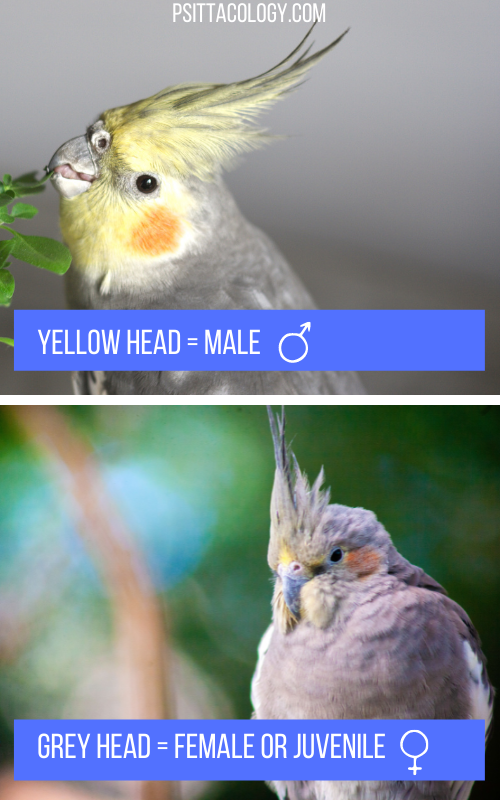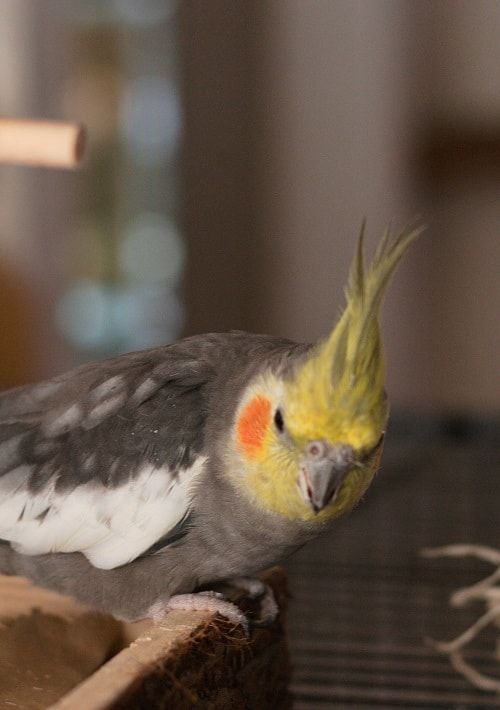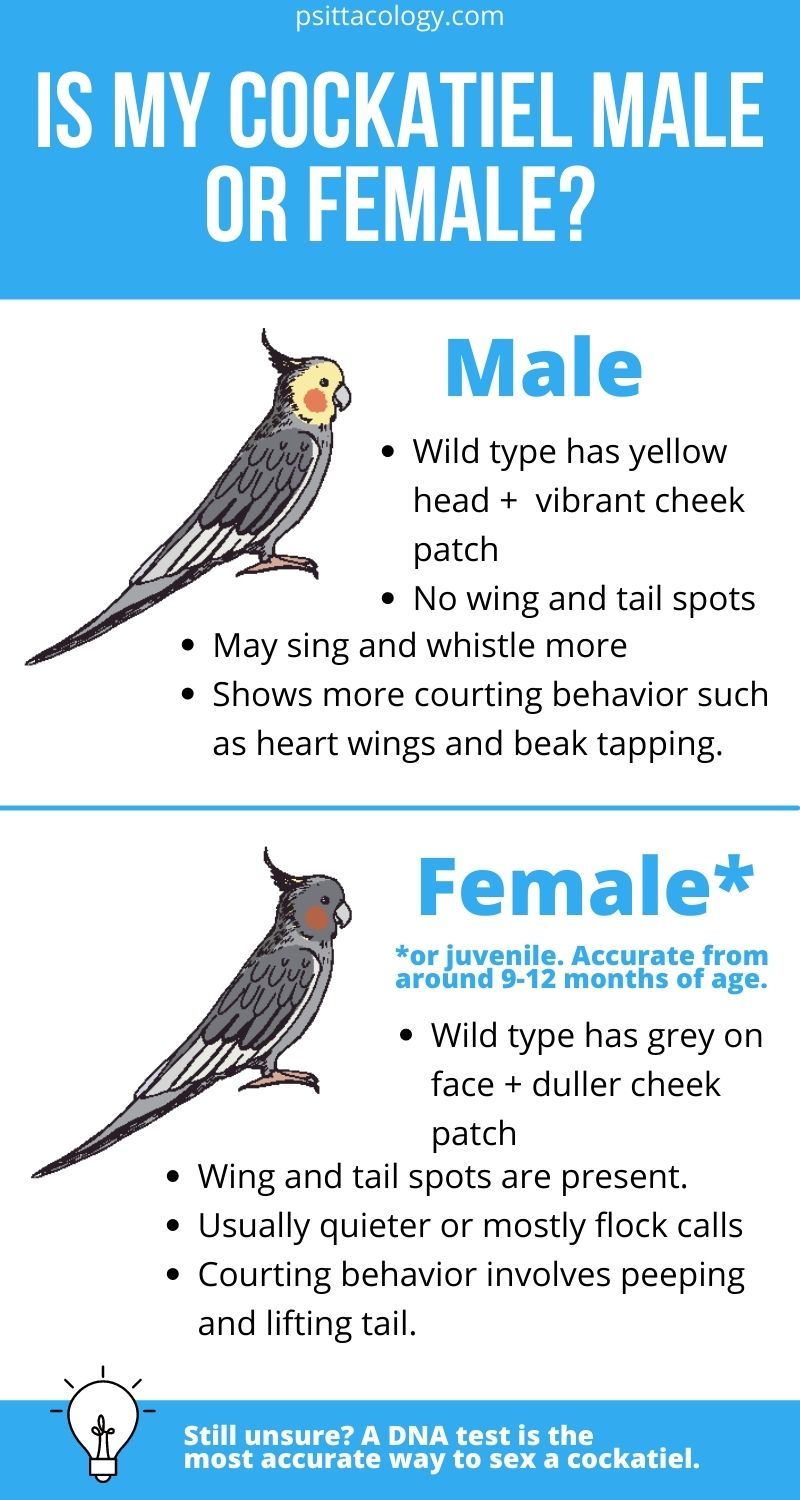Thinking of getting a cockatiel (Nymphicus hollandicus) or already have one whose sex you’re not sure about? These birds can be sexually dimorphic, meaning that sexing a cockatiel is often possible just by looking at it. But what should you be looking for?
Keep reading for everything you need to know about sexing a cockatiel and figuring out whether your bird is a boy or a girl.
This post contains affiliate links. If you make a purchase, a small percentage will go directly to Psittacology at no additional cost to you. Thank you for supporting Psittacology!
Does sex matter?
Before going into how to tell whether a cockatiel is a boy or a girl (visually, by means of behavioral indicators, or using a DNA test), let’s quickly have a look at why it’s actually important.
If you take a quick look at cockatiel forums and Facebook groups, you’ll undoubtedly see plenty of folks trying to figure out their bird’s sex. Why? Does it actually matter? Well, part of it is probably just humans wanting to assign an accurately gendered name to their pets.
This being said: yes, sex does matter to a degree. This especially applies to female birds. Even if your female cockatiel doesn’t have a mate, she still has the capacity to lay eggs, a process that’s pretty heavy on the body. It’s something the casual bird owner is best off trying to avoid.
The above means that if you know you own a female cockatiel, it allows you to be more vigilant. If you see nesting behavior, you can act quickly to discourage it. If she appears hormonal, you might be able to halt the egg production by taking measures.
Additionally, if you notice your cockatiel appears not to be feeling well, it’s helpful to be able to check the bird for female-specific issues like egg-binding.

Sexing a cockatiel | Visual indicators
Cockatiels are naturally pretty easy to sex. Grey wild-type cockatiels are pretty sexually dimorphic, with the males sporting a yellow face while the females are a muted grey almost all over. The males also lack spots and barring on the undersides of their wings and tail feathers, which the females do have.
The problem? Selective breeding has produced many cockatiel colors and mutations that are pretty far removed from the wild type. Gone are the days of grey only!
All this is good news for folks who love variety and unique-looking birds, but it does present an issue in terms of sexing a cockatiel. The normal visual indicators are less clear or disappear entirely in some of these selectively bred colors.
Things to keep in mind
Before we look at the cockatiel sexing chart, I want to remind you that your bird has to be an adult in order to accurately sex it in almost all cases. This is because juvenile cockatiels resemble adult females, with even the males lacking their typical light facial colors.
The males will also show spots and barring on the wings and tail, just like females. It isn’t until after their first molt or two, between 9-12 months, that their male-specific colors really start to show clearly.
Additionally, don’t forget that some cockatiels just don’t follow the visual rules. If you want to be 100% sure, your best bet is to either do a DNA test (which we’ll discuss further down) or hope an egg appears to clear your doubts.
Cockatiel sexing chart
Let’s have a look at some of the more common cockatiel colors and mutations, as well as whether sexing them is possible just by looking at them (and if so, how!).
| Cockatiel color | Indicators of male | Indicators of female |
| Wild type | Yellow head; no wing or tail spots/barring | (Mostly) grey head; wing or tail spots/barring present |
| Lutino | No wing or tail spots/barring | (Very) faint wing or tail spots/barring |
| Pearl (non-pied) | Pearls (spots) gone on adults | Pearls (spots) remain on adults |
| Albino* | Bad luck! None. | Bad luck! None. |
| Pied (any type)** | Bad luck! It’s all over the place. | Bad luck! It’s all over the place. |
| Whiteface | White head; no wing or tail spots/barring | (Mostly) grey head; wing or tail spots/barring present |
| Cinnamon, fallow, silver, yellowface, pastelface, olive, emerald | Wild-type rules apply unless another mutation is present | Wild type rules apply unless another mutation is present |
**Seriously, don’t even try. Females can have a fully light face and males a dark face.
Did you know? It’s often claimed that one can sex a cockatiel by the brightness of their cheek patches. Although this is true in wild types – males usually sport much brighter patches – the other mutations make this method much too vague.

Sexing a cockatiel | Behavioral indicators
Going by the colors, as described above, can be a reasonably accurate method of sexing a cockatiel, as long as the bird is an adult and you remember that pieds are out of the game. Going by behavior is a lot less accurate, as some males can absolutely behave like females and vice versa!
This being said, there are some general differences between male and female cockatiels in terms of behavior. It’s handy to see it as a spectrum: some ‘tiels behave like the stereotype for their gender, while others are a lot more neutral or lean more towards the other gender.
In any case, this can be a good way to confirm things if you already have a hunch.
Indicators of a male
If we view sex-dependent behavior in cockatiels as a spectrum, we can expect males who lean more towards typical manly behavior to be real flirts. They do the work in wooing the girls, so they need to be flamboyant.
A few typical male behaviors include:
- Heart wings: The bird extends its wings, which makes a heart shape when seen from behind.
- Singing: Often combined with heart wings. Male cockatiels tend to be more vocal and also more talented when it comes to picking up tunes.
- Beak tapping: The more noise it produces, the better.
- Strong reaction to mirrors: Macho males will be unable to resist flirting with their reflection.
- Dancing: Whether it’s bobbing, strutting or hopping, the boys are pretty expressive.
- Masturbating: Yep… it happens. Frustrated males might mount their toys and other objects.
- Social contact: Males are said to be less reserved and more outgoing. I do feel this has a lot to do with early socialization, so it’s not the best indicator.
By the way: Baby cockatiels won’t show much typical gendered behavior. They’re too busy being babies! You’ll have to wait 6-12 months for the first clear signs.

Indicators of a female
- Social contact: The most common characteristic attributed to female cockatiels is that they’re less outgoing. As mentioned, though, this has a lot to do with how the bird was raised.
- Vocalization: Although some females do sing, most of them stick to flock calls. Peeping noises are common during courtship.
- Mating behavior: When confronted with a suitable partner or even sometimes an object, female cockatiels might crouch down and lift their tail.
- Masturbation: A female cockatiel might try to back up against an object rather than try to mount it like a male would.
- This one goes without saying, but still… if it lays an egg, it’s definitely a girl.
Did you know? Because both parents are involved in raising the chicks, nesting behavior in cockatiels doesn’t really say much about their gender. The males can get just as territorial over their (imaginary) nest as the females.

DNA testing a cockatiel
It used to be pretty much impossible for the casual parrot owner to have their bird sexed using a DNA test. It was very expensive and something really only reserved for breeders and professionals. Gone are those days! DNA sexing for parrots is very affordable and easy now.
In most cases, you’ll buy a parrot DNA test online or at your local pet store. The test usually requires you to pluck one or multiple feathers from your bird and send them to the address listed on the test. Fresh eggshell or toenails may also work; the instructions will specify this.
Once your test company of choice has received the material you submitted, the DNA sexing is performed in a lab using a PCR test. The accuracy of these tests is very high and results are simply emailed to you. Perfect for those pesky pieds and albinos, as well as cases where you’re just not sure based on color and behavior.
The most common parrot DNA test is by Pollygene.
Did you know? A method sometimes used for sexing a cockatiel is feeling the pelvic bones. They will be wider apart in females. That being said, this doesn’t work when a bird is younger and it’s also pretty difficult to tell when you’re not an expert. If you know what you’re doing, you could use this to help confirm a hunch, though!
If you have any more questions about sexing a cockatiel or if you’d like to share your own experiences with these gorgeous Australian parrots, don’t hesitate to leave a comment below!
PS: If you guessed male on the last image, you were correct.
Want to read more about cockatiels and how to keep yours happy and healthy? Don’t forget to have a look at the full cockatiel care guide.
Reed, N. A. (1980). Cockatiel Sex Symbols. AFA Watchbird, 7(3), 4-9.


Really good article,interesting.looking forward to more info.
My lutino cocktails babys tail is full of yellow color…
That’s normal! 🙂
I have a 3-month-old cockatiel I don’t know if she’s male or female but she’s so outgoing she’s so precious she’s already comes out of her cage and she she comes and lays on my chest and she actually comes up and gives me kisses if I make little lip noises with my lips she comes up and kisses me on the lips yeah such a precious bird God bless
Thanks for sharing, that’s adorable! Hope you guys have many happy years together. As you’ve read in the article you should be able to tell soon in most cases, or you can try a DNA test 🙂
So did mine for a couple months and then something happened and he became the meanest bird you ever want to see you cannot touch him you cannot talk to him and you cannot know him climb up on you because he’ll get you by the face
You could consider contacting a parrot training expert if you’re having this kind of trouble with your bird. They can often help you pinpoint where things are going wrong to cause this sort of behavior, as it’s not natural to these birds. Good luck!
have you changed anything? location of cage; gotten another pet, moved its toy, gotten a new toy , new cage. think about it.
Hi I have a Lutino Pearl, and it is slowly getting used to me. He or she will come
out of the cage or yell when it doesn’t see me. And will fly down to look for me. It also comes to me with head bowed down wanting to be petted. It also at times will raise it’s back end while I’m petting down it’s back. I had males in the past. So not sure what this one is, but it really doesn’t matter the sex.
What do you think?
Thank you!
Hey! I’m afraid I really can’t say much about its sex based on the info you’ve given me. Since it’s so difficult to see in this color mutation, you could consider a DNA test. It can be good to know just because females may need different care.
By the way, I don’t recommend petting any parrot on its back. It’s considered a sexual gesture and may invoke undesired hormonal behaviors in them.
Good luck! 🙂
i wish i knew when i was younger o.O
Yeah, it’s something relatively well-known in parrot circles now but I know a lot of us have been unknowingly guilty of it!
Just got a rescue teil – looks like a pied – was told she’s female and around 4 yrs old
I’ve also had a 24 year old – Lutino – I think, and was told by a vet that he was a male – today , after they’ve been acquainting and finally together the pied mounted the lutino a few times – I’m so confused? They have been so sweet together but this happened on the roof of one of their cages and they both plopped down – I’m concerned for his safety- can the pied by a female and do this? HELP!
Hello! Sorry to hear you’ve got some confusion going on. With the pied cockatiel, were you told the ID was based on a DNA test? Because as discussed in the article, it’s not possible to definitively sex a pied ‘tiel in any other way. Sure, you can look at behavior and such, but it’s always going to be a bit of a gamble! For the lutino, you could check for the tail spots and barring as described in the table, but in your situation I’d just DNA test both of them!
It’s possible they’re both males. I have a male/male couple and one mounts the other all the time – which also often results in them falling from the cage, actually. Anyway, good luck! Hope you can figure it out, but at least it’s nice they get along so well.